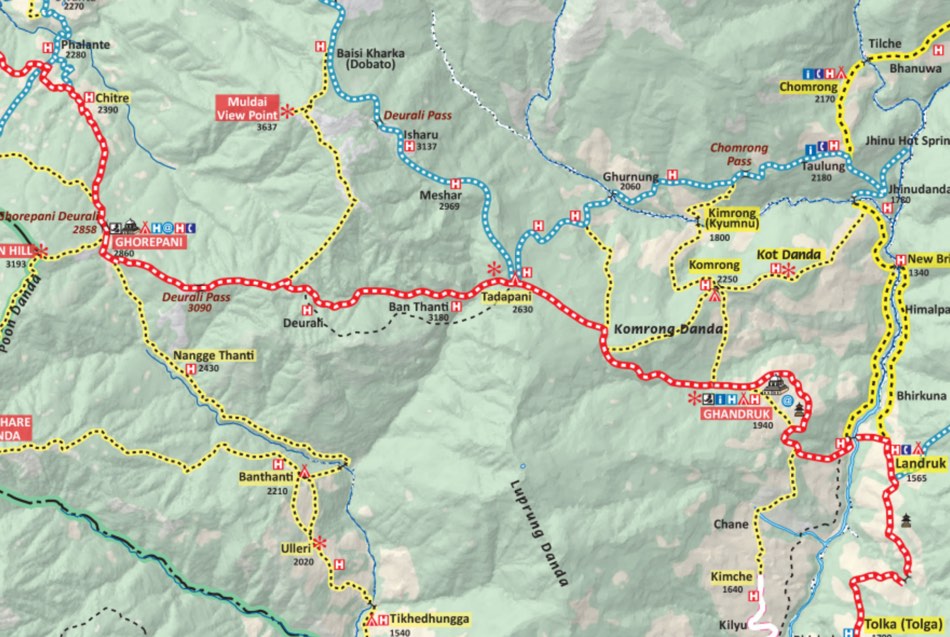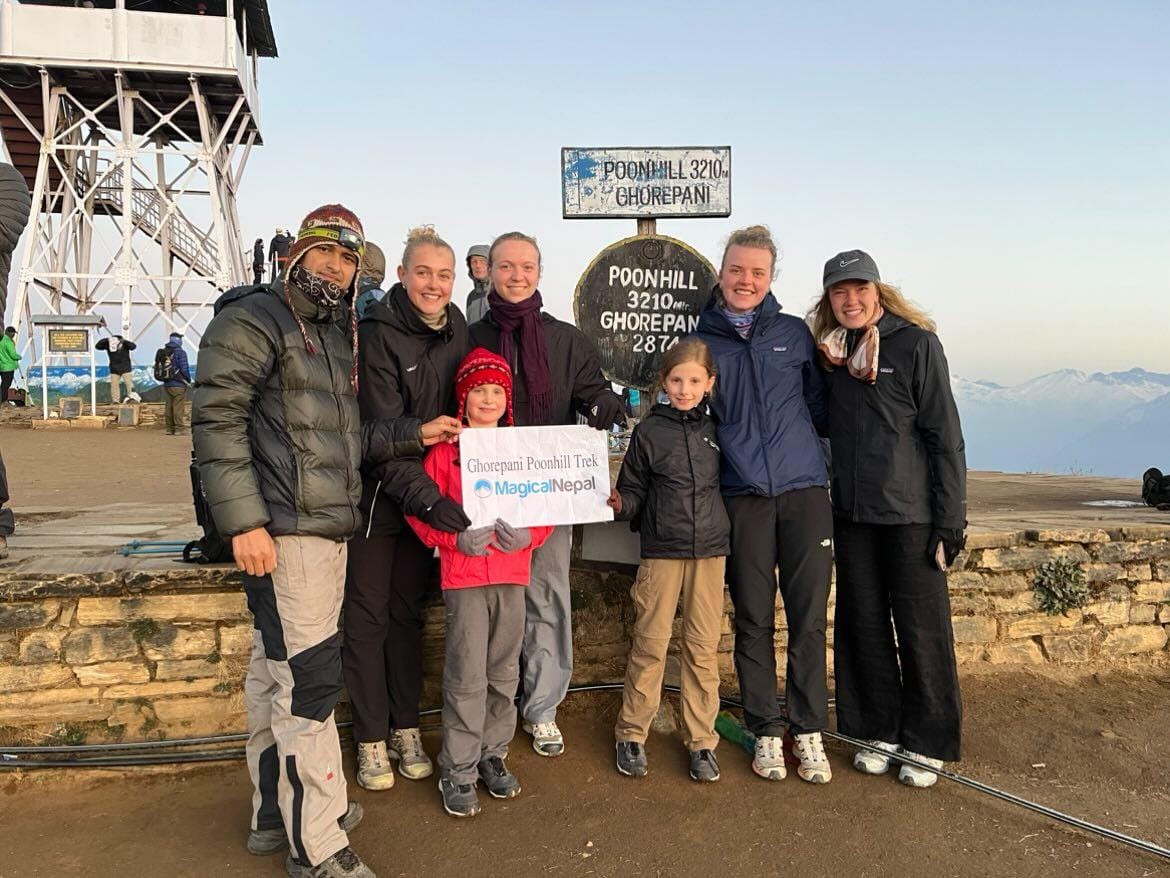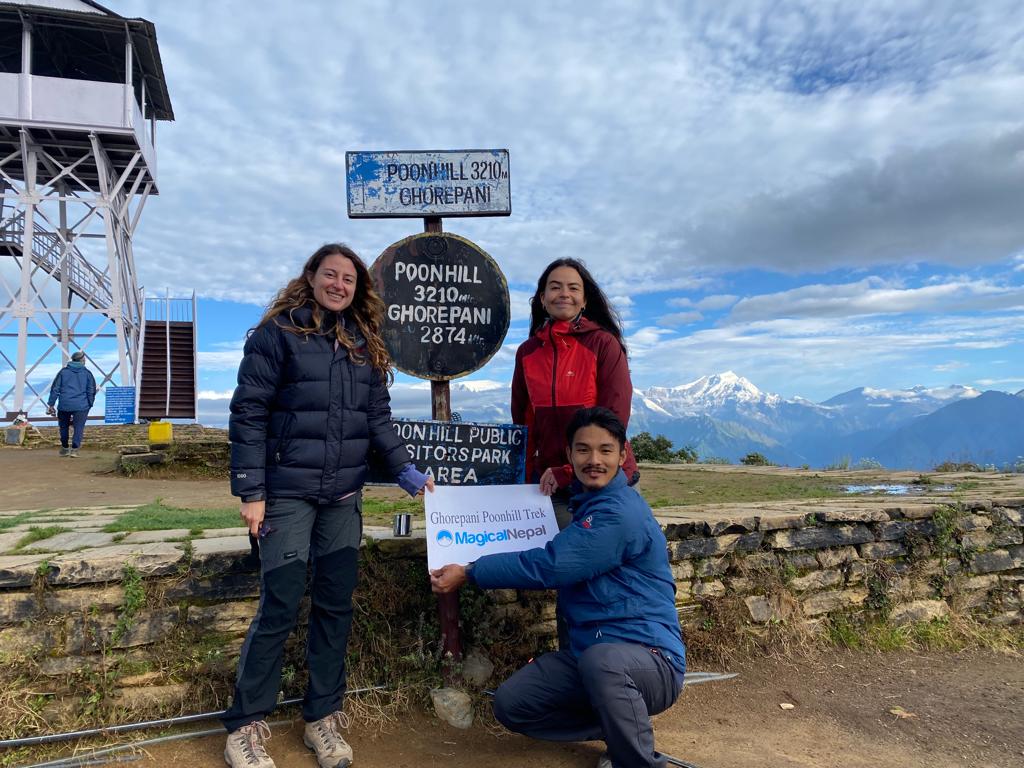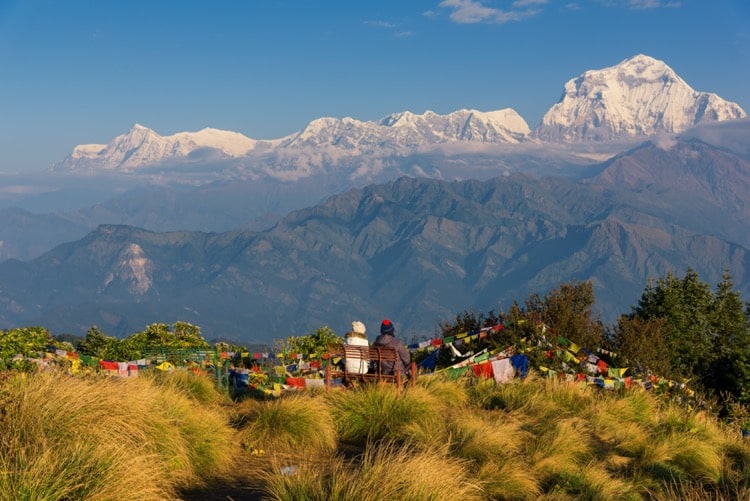Ghorepani Poonhill Trek
- Satisfied Client
- Personalised Guide
- Instant Response
Get Instant Response:
+977-9851329446 (Whatsapp)
| Starts at: Naya Pool | Ends at: Naya Pool |
| Trek Region: Annapurna | Transport: Tourist Bus |
| Duration: 7 Days | Trip Grade: Easy |
| Max Altitude: 3,210 m / 10,503 ft (Poonhill) | Accommodation: Teahouse |
Ghorepani Poonhill Trek Highlights
- Spectacular sunrise/sunset views on the chain of Himalayas from Poon Hill
- Best panoramic views of Annapurna, Dhaulagiri, Machhapucchre, Hiunchuli, Nilgiri, and Mardi
- Ascend and descend the popular stone stairs of Ulleri village
- Forget all your lethargy & pain of walking because of the amazing hospitality locals offer
- Walking through the lush forests, scattered Gurung settlements
The Ghorepani Poon Hill trek is perhaps the ultimate short trek in the Himalayas! Suitable for people of all ages, particularly for families with children, this trek can be 4 or 5 days long and still gets into the heart of the Annapurna. Poon Hill (3,210m) is the ultimate viewing point for the Annapurna range, Dhaulagiri, Nilgiri, Tukuche, Varaha Shikhar, and Lamjung Himal.
Hiking up to Poon Hill to watch the sunrise over these stunning snow-covered mountains is something to be treasured.
This trek also includes hiking through colorful villages and rhododendron forests, with the backdrop of the Annapurna always present.
Even for experienced trekkers, this is a great introduction to the Himalayas, especially if time is short. Accommodation along this established route is very comfortable, and the menus are not disappointing. And, of course, the mountains never disappoint either in their fully photogenic beauty!
A Typical Day on the Poon Hill Trek
The Ghorepani Poon Hill Trek is considered an easy trek in Nepal. That’s not to say you can go straight from your couch to the mountains! A reasonable level of fitness is required. But it can also be a family trek, with children and older relatives being able to participate and enjoy themselves.
This trek ends in Kathmandu with a day at the start and another day at the end in Pokhara. This is a beautiful way to start and end your trek.
Pokhara is right in the Annapurna range mountains, so this will be a trek filled with snow-covered mountains and beautiful landscapes.
As on most treks, the day starts early – around 6 or 7 am. Except for the day when you climb up Poon Hill. That day starts before dawn, to make it up the hill to watch the spectacular sunrise over the mountains. Then you hike back for breakfast before heading off to the next location.
On each day, after breakfast, you set off with your guide, who will be able to point out the most interesting sights and let you know the names of the mountains on the way.
Lunch on treks is taken in teahouses along the way.
On arrival at the teahouse (trekking lodge) where you are going to sleep, it is best to order dinner straight away to give them time to prepare it. You can chat with other trekkers and your guide during and after dinner. And to find out what is in store the following day.
Don’t forget to order breakfast before bed, and we suggest sleeping early on the trek!
Ghorepani Poonhill Trek Outline Itinerary
Day 1: Kathmandu to Pokhara (Drive)
Pokhara – 830 m / 2,723 ft – 7 hrs
Day 2: Pokhara to Naya Pool (Drive) to Tikhe Dhunga
Tikhe Dhunga – 1,570 m / 5,150 ft – 6 hrs
Day 3: Tikhe Dhunga to Ghorepani
Ghorepani – 2,850 m / 9,350 ft – 6 hrs
Day 4: Ghorepani to Tadapani (Morning hike to Poon Hill)
Tadapani – 2,700 m / 8,858 ft – 7 hrs
Day 5: Tadapani to Ghandruk
Ghandruk – 1,940 m / 6,364 ft – 3 hrs
Day 6: Ghandruk to Naya Pool to Pokhara (Drive)
Pokhara – 830 m / 2,723 ft – 7 hrs
Day 7: Pokhara to Kathmandu (Drive)
Kathmandu – 1,300 m / 4,265 ft – 8 hrs
Day 1: Kathmandu to Pokhara (Drive)
Drive Time: 8 hours
Accommodation: Hotel
We start off early, but with time for breakfast first. The road out of the Kathmandu Valley twists its way down the valley wall until it joins the Trushuli River below. Here we see rafters braving the white water – perhaps this is your future trip in the planning – and can see snow-capped mountains in the distance.
Once we reach flatter land, we stop for lunch before heading on to the lake city of Pokhara. After checking into the hotel, there is time to explore the neighbourhood: the walkway along the lake, the varied and interesting shops and restaurants, and of course, the mesmerising Fishtail Mountain towering over the city.
Please note that we use comfortable tourist buses on this route, but if you would like to hire your own personal car or flight. Please, check to add on while booking.
Day 2: Pokhara to Naya Pool (Drive) to Tikhe Dhunga (Trek)
Trek time: 6 to 7 hours
Accommodation: Tea House
After breakfast, it’s a relatively short drive to Naya Pool, the start of your trek. There is the choice of bus, local jeep, or private car/taxi to reach.
From Naya Pool, it’s time to get hiking! Passing the checkpoint at Birethanti, the road gently climbs to Tikhe Dhunga. It takes approximately 4 to 5 hours to hike to the overnight lodge at Tikhe Dhunga. Thankfully it’s not a difficult trek today, but enough to wake up your hiking legs!
Day 3: Tikhe Dhunga to Ghorepani
Trek time: 6 hours
Accommodation: Tea House
Crossing the suspension bridge near Tikhe Dhunga, we brace ourselves for today’s hike! It’s more of a climb than a hike, with (well) over 3,000 steps on the steep stone staircase leading up to Ulleri village. Preparing in advance by taking the stairs rather than the lift/elevator at home would be a great advantage.
Above Ulleri and coming out of the forest, the trail becomes more gentle, crossing pastures and fields. Passing Banthanti village, we head on to Ghorepani, where we spend the night. Already we can see several mountains, including Annapurna I (8,091m / 26,545 ft) and Dhaulagiri (8,167m / 26,794 ft).
Day 4: Ghorepani to Tadapani (Morning hike to Poon Hill)
Trek time: 6 to hours
Accommodation: Tea House
Waking before dawn, we hike for about an hour up Poon Hill (3,210m) to watch the sunrise over the Himalayas! Hot tea is usually available in the early morning chill we sip while taking in the amazing scene of a huge array of mountains. These mountains are Hiuchuli, Nilgiri, Dhaulagiri, Tukuche, Annapurna South, Annapurna I, II, III, IV, Lamjung Himal, and Machhapuchhre (Fishtail) – and many more, which your guide will point out to you.
Once the sun has risen spectacularly over the mountains and we have clicked enough photos, we drag ourselves away and head back down to the lodge in Ghorepani for a well-deserved breakfast before heading on to Tadapani.
The trail to Tadapani starts off quite steep until we cross the Deurali Pass, when the path becomes more forgiving. From the Deurali Pass, we get a second chance to take the mountains we saw from Poon Hill. Overnight in Tadapani.
Day 5: Tadapani to Ghandruk
Trek time: 3 to 4 hours
Accommodation: Tea House
Today it’s a shorter trek, giving us plenty of time to explore Ghandruk, one of the largest Gurung villages. One of the Gurung Culture Museum highlights is an insight into people’s lives.
It is mainly Gurungs who are the fierce and loyal Gurkha soldiers in both the British and Indian armies. With snowy peaks, rest and relaxation are welcome breaks today.
Day 6: Ghandruk to Naya Pool to Pokhara (Drive)
Trek time: 7 to 8 hours
Accommodation: Tea House
Enjoy the final breakfast of the trek before hiking through villages to reach Naya Pool, where we can take a bus or jeep back to Pokhara. Tonight enjoy the bright lights of the bars and restaurants in Pokhara and gaze once again at the lake and up at Fishtail Mountain.
Day 7: Pokhara to Kathmandu (Drive)
- Trek time: 8 hours
After breakfast, head for the tourist bus or have your private vehicle meet you at your hotel for the drive back to Kathmandu.
Not satisfied with this Itinerary?
Are you interested on planning custom trip? It only takes 2 minutes.
Includes
- 4 nights accommodation in mountain teahouses
- 2 nights accommodation in Pokhara (Kuti Resort or similar)
- Guide for 7 days
- Pokhara Naya Pool Pokhara private car
- Kathmandu Pokhara Kathmandu tourist bus
- Annapurna conservation area permit
- Trekkers information management system card
- 5 x breakfast, 5 x lunch and 4 x dinner while on the trek
- One Porter for 7 days USD 128
- Lunch and dinner in Pokhara
Ghorepani Poon Hill Trek FAQ
Equipment Checklist for Ghorepani Poon Hill Trek
The checklist gives you an idea of the trekking equipment and clothing needed for the Ghorepani PoonHill Trek.
Ghorepani Poonhill Trek Map

What to Expect in a Teahouse in Poon Hill Trek
A teahouse is like a simple guest house on the mountain trails. It provides trekkers with accommodation, meals, and a place to socialize. On the whole, these provide pretty basic accommodation, either in twin rooms or in dormitories. Toilets and bathrooms are shared, with either a Western-style toilet or a squat style. Showers normally only have cold water; you will be expected to pay for it in those with hot water.
The sleeping rooms consist of beds, blankets, and not much else. Bringing your own sleeping bag is always recommended. There are no ‘single rooms’ unless it is off-season, and you are lucky. Sharing a room is perfectly normal. There is no heating in the sleeping rooms.
Since this area sees many tourists and has been open for trekkers for decades, the facilities can be better than in some more remote areas of the country.
Some stove usually warms the dining area. Light is provided by solar or electricity. Most teahouses have the ability to charge your gadgets, for which you have to pay. Breakfast and dinner are taken in the teahouses at communal tables where you can discuss the day’s journey with others.
Some menus offer a variety of food. Boiled water is usually available, rather than in plastic bottles, which hurts the environment. There is a small charge for boiled water. Bringing your own sterilization tablets/ life straw is a good idea.
What kind of food is available on Poon Hill Trek
Again, because this is a busy, well-established trekking route, the food on this trek is better than in some more remote areas.
There is quite a good choice on the menu, including Western, Indian, Chinese, and Nepali food.
Tea and soft drinks are widely available at the teahouses. There will be coffee, hot chocolate, and alcohol too.
Breakfast at your overnight teahouse on the Ghorepani Poon Hill Trek:
- Spicy Nepali omelet with chili, onion, and tomatoes or piping hot porridge with milk
- Toast with jam or honey
- Nepali spiced tea or coffee
Lunch on the Ghorepani Poon Hill Trek:
- Dal bhat (rice, curry, lentils) or chowmein (when available)
- Nepali tea or a soft drink
Dinner at your overnight teahouse on the Ghorepani Poon Hill Trek:
- A variety of soups
- Tibetan bread
- Fried macaroni with vegetables
- Pasta
- Pizza (of a simple style)
- Curry
- Fried rice
- Custard
- Rice pudding
- Beer/ spirits (we recommend you limit your consumption while on the trek),
- Tea/ Coffee
Are There Hot Showers on this Trek?
Yes, hot showers are available, but you must pay for them. Why? Gas canisters are brought in from nearby cities and carried to teahouses. That is an expensive journey. You will be expected to pay around $3 to $5 per shower, depending on the height of your lodge. We recommend you conserve energy (and your money) and don’t shower too often. And the effort to take off and put on clothes might be too much in the cooler weather.
How High Will, I go on Ghorepani Poon Hill Trek?
The highest point for this trek is Pooh Hill itself at 3,210m.
Poon Hill Trek Difficulty and Physical Fitness Required for this Trek?
It is considered a moderate trek, but a good fitness level is still required.
Will I suffer from Altitude Sickness in Poon Hill Trek
It is highly unlikely you will suffer from altitude sickness on this trek. The highest point is Poon Hill at 3,210m. While some people may feel some effects of altitude over 3,000m, you will only be at this height for a couple of hours, not long enough to cause any problems. In case of problems, however, our guides are fully experienced and knowledgeable about what to do.
Extending your Stay in Nepal after Ghorepani Poon Hill Trek
As your trek ends in Pokhara. You may wish to extend your stay there. You can ask us about reserving a hotel for you or arrange on your own.
If you are interested in staying longer in other parts of Nepal, we can organize that for you and make recommendations for the best trips to suit your time and budget. Please ask us.
If you would like to visit another part of Nepal, we can recommend both Chitwan National Park and Bardia National Park. Or if your time is short, we can provide Kathmandu Heritage sightseeing with a guide, taking you into a fascinating ancient world and culture.
Trip Extension: National Parks after Poon Hill Trek
Both Chitwan and Bardia are beautiful national parks in Nepal. But both are different regarding location, difficulty getting there, facilities, and, to some extent, wildlife.
Chitwan is very close (around 5 hour drive or a short flight) from Kathmandu and has been established as a national park open for visitors for decades. It is easy to spend 2 nights in Chitwan with little difficulty because of the distance to Kathmandu. As a result, there is a wide range of accommodations, some quite luxurious. There is also a range of restaurants and bars in the tourist town of Sauraha for those who would rather party the night away. The wildlife guides provide walking safaris, jeep safaris, and short canoe rides. The main animals of interest are rhinos, deer, leopards, monkeys, and smaller mammals. Tigers do live here but are quite difficult to spot.
Bardia National Park is situated at the other end of the country and takes around 12 hours to reach by road or 1.5 hours flight then 2 hours drive. We recommend staying at least 3 nights to enjoy the ambiance here fully. It is less busy with tourists and more rustic in terms of accommodation and local villages. Wildlife here consists of tigers, elephants, leopards, monkeys, and deer. Like Chitwan, there is a huge range of bird life for those interested in bird watching. Jeep and walking safaris are offered, and rafting on the river with perhaps fishing. Nightlife here is more confined to your lodge.
There are now options for wildlife spotting between these two parks. The village of Megauli, which is really in Chitwan District, is an up-and-coming place in terms of luxury lodges. Currently, it does not see a lot of visitors but offers the same safari options of the jeep and walking safaris. It is more difficult to get to than Chitwan and requires either a private vehicle or to be collected from the nearest big town by the lodge vehicle.
Cost and the Booking Process for the Ghorepani Poon Hill Trek
You can book your trek and other trips via our booking system, which will collect all the necessary information from you. You can pay the deposit or the full amount via credit card.
Do I Need a Porter for this Trek?
The cost of this trek does not include a porter. Should you require a porter, there is an extra charge of around USD128 per porter. If you hire a porter, please be considerate. Porters cannot carry everyone’s pack! The weight limit they can carry is 20kg. Or one porter for two clients.
These amazing people are used to walking at altitude and on these rough trails, so they walk faster than the average trekker. As they will head off ahead of you and reach the teahouse first, where they will deposit your bag, please ensure you carry what you need for the day with you.
Charging Your Equipment on the Trail
Many teahouses on this trek have electricity or solar-powered electricity. But as almost everyone carries some sort of chargeable device these days, the teahouse owner will pass the cost along to the visitor.
Generally, teahouses will charge you $2 to $3 for your phone or camera. This can become expensive as there are so many wonderful things to photograph. We recommend you carry a power bank or a small solar charger to avoid paying too much. There are some great solar chargers that clip onto your day pack.
Will I be Able to Communicate with Those at Home During Trek?
Yes, there is Wi-Fi and cellular signals at all stages of this trek.
Group Size for the Ghorepani Poon Hill Trek
Your trekking group is generally 8 people, but it is often smaller. If you require a tailor-made private trek, you can choose this option at no additional cost during checkout.
We have found that trekking with a group makes the trip more fun, especially during the evening relaxation.
How do I get from Kathmandu to Pokhara?
We will pick you up at your hotel in Kathmandu, take you on the tourist bus from Kathmandu to Pokhara, and then transport you to the hotel in Pokhara. The following morning we will go by bus or car to the start of the trek.
If you wish private transport to/from Pokhara, please ask us about this price.
Arriving in Kathmandu
We will pick you up at the airport in Kathmandu and take you to your hotel. If you are late (flight delay etc.) and have been unable to contact us to let us know, please make your way to the hotel. There are pre-paid taxis at the exit of the airport, which will cost you around Nrs600 – Nrs800 to Thamel. A few people might come up to help you with your bag and later ask for money. Ignore them.
Travel Insurance for your Trek
While our insurance covers our team, you are not covered by this. Please ensure you have the correct travel insurance before leaving home.
Safety and Security in Nepal and on the Ghorepani Poon Hill Trek
In general, Nepal is a very safe country. But please check your home government’s website for the latest information. There may be demonstrations – if you see one, please avoid it. Theft is unusual, but it does happen. Ensure all your valuables are hidden from sight. You can leave any valuables in our office locker while on your trek.
It is unlikely, but if there is any landslide, avalanche, flooding or earthquake on the mountain, please follow instructions from your guide. Similarly, if you feel unwell at all, please advise your guide.
Tipping Culture in Nepal
It is expected in restaurants and cafes to tip 10% of the bill. Tipping your driver, porter, guide, and another staff on your trek is also normal. Please tip drivers of private vehicles separately. $1 to $5, depending on the length of the journey. Normally tips for the trekking crew are given as a group and depend on the group’s satisfaction.
How Much Cash Should I Take on the Trek?
We recommend you carry between USD10 to USD15 per day on the trek. This will cover things like hot showers and charging batteries. It also will cover the occasional soft drink or beer. It will not cover tipping your crew/guide on longer treks.
How Much Cash Should I Take on the Trek?
Please respect the local culture. For example, when entering someone’s house, please remove your shoes and leave them outside. This does not apply to trekking lodges. Please dress respectively when visiting religious sites of any kind. Public displays of affection between men and women are still rare in Nepal. Whatever you may witness in
Money Exchange in Kathmandu and Pokhara
There are plenty of ATM machines in Kathmandu which provide Nepali currency. There are also ATMs in Pokhara. TheThere are plenty of ATM machines in Kathmandu which provide Nepali currency. There are also ATMs in Pokhara. The ATMs accept Visa and Mastercard and have a limit on each withdrawal. Some shops accept Visa and Mastercard also, but there will be a 3 or 4% charge for each transaction. The rate of exchange varies daily at both ATMs and money changer booths. Money changer booths will only change hard currency into Nepali rupees. They do not accept cards. Often it is easier to bring some US dollars, Pounds, Australian Dollars, Singaporean Dollars, Malaysian Ringgit, and Euros with you.
Money Exchange in Kathmandu and Pokhara
After your trek, we would love to hear from you about how you enjoyed the trip and any suggestions on improving the experience for others.
Important Notes for the Ghorepani Poon Hill Trek
- Transport is by tourist bus and public bus. If you wish to use private transport, please choose it during the checkout, which will involve an additional fee.
- There is no extra charge for a solo traveler. But please note it is highly unusual you will be able to get a single room on the trek. Expect to share with someone (of the same sex). Let us know if we can arrange a single room for you in Pokhara.
- This trek does not include any accommodation in Kathmandu. If you would like us to book this for you, please let us know in advance.
- Porters are not included in the package price. Please choose it at the checkout if you wish for a porter to carry your gear.
- If you hire a porter, the maximum he can carry is 20kg. Please be respectful of this.
- Meals on the trek are included in the price. This does not include hot or cold drinks, alcohol, snacks, or extra food.
- Breakfast is included in Pokhara, but lunch and dinners are not. There are plenty of restaurants around your hotel to choose from.
- Extra charges for hot showers ($3 to $5) and charging your battery ($1 to $3) are payable directly to the teahouse on the trek.
- Always listen to your guide. He has experience in this area, and if sudden changes are to be made (because of weather or landslides), he will be responsible for making decisions.
- Drones are not permitted unless you have a special permit to fly them. It is tricky to obtain permission, so leave it at home unless you need a drone.
- Please arrange trekking insurance before leaving your home country. We do not provide insurance for our clients.
- Most of all – enjoy your adventure!
Related Trip in Annapurna Region
Mardi Himal Base Camp Trek | Annapurna Base Camp Trek | Dhaulagiri Circuit Trek | Nar Phu Valley Trek | Upper Mustang Trek | Tiji Festival Trek | Annapurna Circuit Trek | Nar Phu Teri La Upper Mustang Trek | Khopra Ridge Trek | Tilicho Lake And Annapurna Circuit Trek | Annapurna Base Camp Helicopter Tour | Saribung Peak With Upper Mustang | Himlung Expedition With Nar Phu Valley


